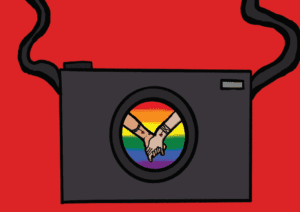Studies on how the media view the issues of individuals, groups, or communities with diverse gender expression and non-normative sexuality—including lesbian, gay, bisexual, and transgender (LGBT)—have been conducted before. However, these studies have not looked extensively into the editorial policies on media reports of LGBT issues. This study by Konde.co with the support of Internews was conducted with the objective of uncovering Indonesian media newsroom policies with regards to issues related to individuals or groups with diverse gender expression and non-normative sexuality, which are collectively labeled as “LGBT”. In this program, Konde.co study revealed how the media write about individuals or groups with diverse gender expression and non-normative sexuality, and what policies are implemented by the media newsroom on this issue.
For this program, Konde.co conducted the following three studies on media policies with regard to individuals or groups/communities with diverse gender expression and non-normative sexuality (“LGBT”):
- Study on media framing on “LGBT” issues on ten online media (March 2020-February 2021).
- Critical analysis of newsroom policies by conducting in-depth interview about editorial policies (in four online media and two televisions) with regard to “LGBT” issues.
- Analysis of in-depth interview with five journalists who identify as gender diverse and sexually non-normative to uncover newsroom dynamics on or treatment of issues concerning individuals or group/community with diverse gender expression and nonnormative sexuality and identify the impact of reporting of such issues on them.
In general, the three studies revealed a number of findings:
- The first study analyzed the way ten online media with the largest readership based on Alexa.com as of July 1, 2021- namely Okezone. com, Tribunnews.com, Kompas.com, Detik.com, Liputan6.com, Merdeka.com, Grid.id, Suara.com, Kumparan.com, Pikiran-rakyat.com framed “LGBT” issues. The researchers selected three stories (all three happened to be crime stories) which were considered representative of incidents involving “LGBT” community due to the relatively massive public attention that they garnered: the story about Mira, a transwoman in Cilincing who was accused of stealing and then was set on fire; the story about the prank on transwomen in Bandung by Youtuber Ferdian Paleka; the story about a “party” in an apartment in Kuningan which was organized by the “gay” community. In general, the study found that the majority of media treated these incidents involving “LGBT” as nothing more than a crime and did not yet see them as discriminatory treatment against the “LGBT” minority. The media also still engage in marginalization of communities with non-normative gender expression and sexuality. The same patterns of marginalization were adopted in writing about “LGBT” community, from word choice which leans toward those with negative connotations to limiting their sources to official authority.
- The second study involved interviews with individuals with the power or authority to control reporting policies, particularly those concerning “LGBT” issues. Previous studies showed that the media had been engaged in the marginalization and discrimination of “LGBT” communities, especially since 2016. Such practice includes publishing statements from state officials which contain hate speech against individuals or groups with diverse gender expression and non-normative sexuality, which are commonly labeled as “LGBT.” This gives the impression that hostility towards “LGBT” community is increasingly becoming institutionalized. Media stakeholders still put the police as primary sources in crime stories involving “LGBT” community, giving the police, the primary persecutors of this community, greater power in public narratives related to gender and sexually non-normative communities.
- The third study involved journalists who identified as gender diverse and sexually non-normative. The researchers found that while media policy makers claimed that they understood and implemented gender inclusiveness, the journalists said that cultural homophobia and transphobia persists in the newsroom. This culture is felt in the social interaction of the newsroom and has an impact on the reporting. The condition distresses journalists who identify as gender and sexually non-normative. The researchers also found that in addition to the internal distress, these journalists are also experiencing external mistreatment, from misgendering to doxing based on their ethnicity, religion and race.
It is hoped that the findings of this study may be of use in policy advocacy to create fair and gender-sensitive newsroom policy in the media. It is also hoped that the study may offer references for civil society advocacy and campaign strategies. The researchers hope that the study may raise the government’s awareness of the need to abolish all kinds of discrimination for the gender-diverse and sexually non-normative communities.

